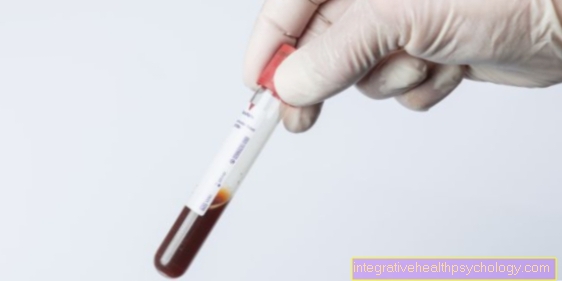urine pH
Definition - What is the normal pH level in the urine?
The pH value in the urine fluctuates over a wide range between 4.8 and 7.6. This means that the urine can be chemically acidic, neutral or basic. The urine is usually slightly acidic and has a pH of around 6.0.
The pH value depends on the diet, medication, lifestyle habits and influences such as stress or lack of sleep and diseases such as urinary tract infections or gout. A vegetarian diet increases the pH level in the urine, while the pH level tends to be acidic when eating meat and fasting.

Does the pH fluctuate during the day?
The pH value in the urine fluctuates during the day. A normal course of the pH values in the urine during the day can look like this:
- 6 a.m.: pH in urine 6.3
- 10 a.m.: pH in urine 7.0
- 1 p.m .: pH in urine 6.5
- 4 p.m.: pH in urine 6.8
- 7 p.m.: pH in the urine 6.3
- 10 p.m .: pH in urine 7.1
Morning urine is usually slightly acidic. An alkaline flood occurs after meals. This means that the pH in the urine should reach at least 6.8 about 1 to 2 hours after eating. During the day there is an "up and down" of the pH value in the urine.
Is there an optimal pH?
The pH value in the urine naturally fluctuates over the course of the day and has a tolerance range between 4.8 and 7.6. The pH value depends on the diet.
The urine is usually slightly acidic, with an average pH of around 6.0. There is no such thing as an optimal pH level like in the blood. This is because the urine fluctuates throughout the day and is influenced by various factors. Too low (acidic) and high (basic) pH values that are not within the tolerance range should be observed. They can indicate illnesses or an unhealthy diet.
You might also be interested in this topic: Why is urine yellow?
What increases urine pH?
There are several reasons for an increased pH.
If you have a bladder infection or a urinary tract infection of the lower urinary tract, the laboratory values change. White blood cells, blood, and increased nitrite levels in the urine are common. In most cases, the pH value (alkaline pH value) is significantly too high when an infection occurs.
A pH of> 7.0 in the urine can be an indication of a urinary tract infection. With a strongly alkaline pH value in the urine, there is a risk of "infection stones" forming. Urinary stones form due to the changed conditions during the infection.
In addition, the pH value in the urine rises significantly, depending on the diet. With a largely vegetarian and vegetable-rich diet, the pH value in the urine is usually higher, i.e. basic (alkaline). The pH value in the urine also increases after meals.
In addition, if the urine sample is left around for too long at room temperature, the pH of a urine sample will also rise. The urine pH must therefore be measured either immediately after urination or during urination with a test strip.
What lowers the urine pH?
If the pH value in the urine is too low, one speaks of over-acidity or acidotic urine.
If you eat a diet rich in meat, the pH value in the urine drops. The pH value also drops during fasting and becomes increasingly acidic. At night the pH value in the urine also drops, which is one of the natural fluctuations in the urine.Over acidification of the urine can be caused by certain diseases.
In the metabolic disease gout, a lot of uric acid is formed. The pH value in the urine becomes lower (acidic) due to the increased acid excretion. Urine pH <6.0 is referred to as "acid rigor of the urine". This promotes the crystallization of uric acid and calcium oxalate into small crystals in the urine.
Metabolic and respiratory acidosis are disorders of the acid-base balance that are associated with hyperacidity. The pH value in the urine drops. An infection that comes with a high fever can also cause the urine pH to get too low. In the case of a fever, more acid accumulates in the body, which is excreted via the kidneys, among other things. A pH value that is too low can be an indication of disorders of the acid-base balance, infections or metabolic diseases such as gout.
There are also diet-related changes in the pH value and fluctuations in the course of the day. When eating a diet with a lot of meat, the pH values in the urine are lower (acidic). In addition, the pH value of the urine is naturally acidic at night.
Does urine pH differ between the sexes?
There is no difference in urine pH between the sexes. In men and women, the pH value in the urine changes depending on the diet and fluctuations during the day.
The pH value has a tolerance range between 4.8 and 7.6 for both sexes and is normally slightly acidic with values around 6.0.
How can I increase the pH in the urine myself?
In order to increase the pH value in the urine, that is, to make it more basic, an alkaline diet is recommended. There are numerous healthy foods that promote the formation of bases in the body.
A vegetarian and / or particularly vegetable-rich diet counteracts over-acidification of the urine and increases the pH value in the urine. Examples of base-forming fruit are pineapples, apples, avocado, bananas, berries, mangoes, peaches and dried fruits. Base-forming vegetables are potatoes, kohlrabi, peas, peppers, carrots, aubergines, beans, cucumbers, leeks, zucchini, raw tomatoes and all types of pumpkin.
Mushrooms such as champignons, chanterelles, and boletus also increase the pH level in the urine.
There are also numerous basic herbs and salads such as rocket or dandelion. If you have a particularly acidic diet, avoiding a lot of meat, sausage and fish can help to increase the pH value. In addition, you can use basic preparations such as Active Bases, UrBase or Soda. It is advisable to check the pH value of the urine with pH measuring strips to check the progress.
How can I lower the urine pH myself?
You can lower the pH level in your urine by consuming more acidic foods.
One should medically guard the desired "acidification" in order to avoid urine values that are too acidic.
Foods rich in purines lead to increased uric acid levels. The acid increases the pH in the urine. Natural sources of purine from food include meat, sausage, fish and seafood. Pulses, seeds such as sunflower seeds and yeast (for example in vegetarian spreads) also contain purines, which lead to acid production. Spinach, Brussels sprouts, broccoli and asparagus are also known as “purine bombs”. A diet rich in purine can be used to specifically lower the pH in the urine.
A reduction in alkaline foods can also lower the pH value in the urine. If you want to lower the pH value in the urine yourself, you should regularly check the course with pH measuring strips.
How can I measure the pH in the urine myself?
In order to measure the pH value in the urine yourself, you need so-called pH indicator strips. You can buy these in any pharmacy.
A urine pH strip contains different pH measuring ranges. Measuring ranges between 4.5 and 8.0 are ideal. Otherwise you can use strips with a scale from 5.0 to 10.0. Hold the pH indicator paper briefly under the urine stream or in a beaker with fresh urine. You can read the result on the test strip after a few seconds.
There is a characteristic color tone for each pH value on the pH scale. Compare the color of the test strip with the color sample on the package insert. The corresponding pH value can be read from the appropriate color pattern on the package insert. The pH measurement in urine does not work with urine that has been in the beaker for a long time, as the pH value changes quickly at room temperature and becomes more basic.
How does the pH change with a cystitis?
Urine changes as part of a cystitis. In most cases, an infection of the urinary tract and the urinary bladder shows a significantly increased pH value> 7.0.
A basic pH value therefore serves as an indication of a urinary tract infection. The E. coli (Escherichia coli) bacterium is an intestinal bacterium that often causes bladder infections. This bacterium has a neutral pH value of 7. It can multiply very well at values that are close to its pH optimum. Therefore, neutral to slightly alkaline values are ideal for E. coli. The different bacteria that cause bladder infections have different properties. Overall, an alkalization of the pH value in the urine is observed, which means that the pH value goes up on the scale from 1 to 14.
If the pH value is very alkaline, there is a risk of "infection stones" forming. This means that urinary stones develop and can cause complications.
How does the pH value in the urine change during pregnancy?
Basically, the pH value in the urine, as well as outside of pregnancy, can fluctuate between the alkaline and acidic range. Normal values are at pH values between 4.5 and 8.
Many pregnant women suffer from acidosis. By eliminating menstruation, the natural elimination of metabolic waste and toxins is somewhat restricted. One speaks of increasing slagging. The pH values of body fluids such as urine drop and the urine becomes more acidic.
However, pregnant women also have an increased risk of developing urinary tract infections. The ureters, bladder or urethra can become inflamed. The bacteria mostly ascend from the urethra to the bladder and sometimes can even reach the kidneys and cause kidney inflammation. In the context of a urinary tract infection, an increased (basic) pH value is found in the urine. This is why the urine pH of pregnant women is checked regularly during prenatal checkups.





























